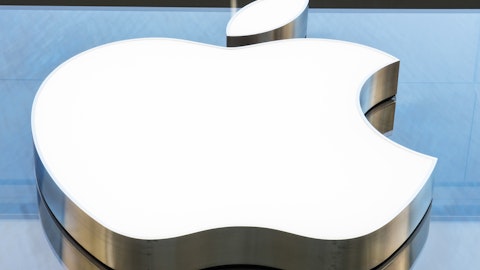Distillate Capital recently released its Q3 2020 Investor Letter, a copy of which you can download here. The Distillate Capital’s U.S. Fundamental Stability & Value (U.S. FSV) strategy’s year-to-date return of 6.20% remains ahead of S&P 500 Index’s return of 5.57% and is nearly 18 percentage points above the Russell 1000 Value ETF’s return of -11.64%. You should check out Distillate Capital’s top 5 stock picks for investors to buy right now, which could be the biggest winners of this year.
In the said letter, Distillate Capital highlighted a few stocks and Apple Inc. (NASDAQ:AAPL) is one of them. Apple Inc. (NASDAQ:AAPL) is a technology company. Year-to-date, Apple Inc. (NASDAQ:AAPL) stock gained 68.9% and on October 12th it had a closing price of $124.40. Here is what Distillate Capital said:
“Over the past five years, Apple’s stock is up nearly 5-fold with the majority of this gain coming in just the last twelve months (See Figure 6). With Apple now accounting for nearly 7% of the S&P 500 Index and having just been sold from Distillate’s U.S. FSV strategy, we wanted to share a more detailed analysis of the drivers behind the stock’s rise along with its positioning in our portfolio. The stock also serves as a useful example of our valuation process and why assessing valuation correctly is critical.
Table 3 contrasts Apple’s fundamentals and valuation at the start of 2015 versus Q3 2020 and highlights a number of key changes. Figure 7 then shows how these fundamental changes are reflected in the stock price change over the same period. As we do in our process, we start with enterprise value (EV), which increased 280% over the period. Within that gain, the first and most basic driver was the change in underlying fundamentals which we measure using consensus estimates for next-twelve month (NTM) free cash flow. While the 50% growth in this figure was substantial, it falls far short of explaining the gain in EV. The much larger driver was the expansion in the valuation multiple paid for those cash flows with Apple’s EV/FCF rising from 10x to 25x – a rather startling change. Then, to assess the value of Apple’s equity, its balance sheet is included. In 2015, cash exceeded debt by $135 billion, but that figure fell to $81 billion most recently. The result is that Apple’s equity value increased 212%, lagging the growth in EV.
Finally, to get to the price of Apple’s shares, the change in the share count must be considered. Apple repurchased a significant number of shares between the start of 2015 and Q3 2020. This near 25% reduction in outstanding shares magnified the increase in equity value on a per share basis. On top of the free cash flow and valuation changes, this repurchase activity accounted for about one-third of Apple’s entire gain in the share price over the period examined – a significant impact.
As Table 3 and Figure 7 emphasize, the change in valuation was far and away the biggest driver of Apple’s extraordinary recent stock price rise. Interestingly, this wasn’t just true of Apple, but also of Microsoft, whose stock has increased nearly 10-fold since the end of 2012 and is now the second largest stock in the S&P 500 Index. As with Apple, Microsoft had been a significant holding in our strategy until its valuation became stretched more recently. With both stocks, an inexpensive starting valuation was the key driver of recent returns. Looking back to the end of the last decade and examining the next twelve month free cash to enterprise value yields of both stocks and the S&P 500 Index highlights how extraordinarily cheap each stock was (See Figure 8.)
As Figure 8 depicts, both Apple and Microsoft offered remarkably cheap valuations around 2012, with free cash to enterprise value yields around 18% compared to just under 6% for the market overall. Stated differently, with an enterprise value yield of nearly 20%, the implicit math suggests all of Apple and Microsoft’s shares and debt could have been retired in just over 5 years. While Microsoft’s valuation improvement began earlier and was more gradual, Apple still offered a free cash to enterprise value yield of around 15% as recently as 2015, and 10% at the end of 2018 before falling to about 4% currently. The percentile ranking of each company’s valuation versus the market on Distillate’s normalized free cash yield methodology is plotted in Figure 9. In both cases, the shares went from the 100th percentile, or absolute cheapest stocks in the S&P 500 Index, to being among the more expensive most recently. (It is worth acknowledging that since Apple and Microsoft are facing fewer fundamental headwinds in the current environment than many peers in the S&P 500 Index, their current rankings may be getting somewhat flattered.)
Valuation Matters: Just how inexpensive both Apple and Microsoft were and how changes in their valuation dove their extraordinary price moves over the past several years is something that we think is being sorely missed in discussions about “value” and “growth” today. First, that the gains of two of the largest stocks in the growth indexes were more driven by valuation changes, rather than growth in their underlying businesses, highlights the importance that should be placed on the price paid for any asset. It also supports the efficacy of paying less for assets as a wise investment strategy while many conversations seem to implicitly suggest the opposite.
Second, with free cash flow yields of nearly 20% of enterprise value, you might argue that both Apple and Microsoft should have been pillars of any value strategy. Yet this was most often not the case since value indexes (and therefore many of the strategies being managed against those benchmarks) tend to emphasize book value to define their constituents. We do not believe book value any onger accurately reflects the true value of assets in a market where many companies derive their profitability from research and development and other intangible investments that are not reflected as assets on corporate balance sheets. See our papers “Value Investing in a Capital Light World” & “Value Failed Because it was Expensive.”)
Lastly, conversations about growth and value often miss that an inexpensive free cash flow valuation itself can counterintuitively be a driver of growth, as it was for Apple. While forecasts for rolling next twelve month free cash flows increased 50% for Apple from the start of 2015 through Q3 2020, the share count reduction amplified the per share impact of this growth by another 32%! And the magnitude of the share count reduction was driven by just how inexpensive the stock price was in relation to free cash flow. Figure 10 shows Apple’s free cash flow yield versus year-over-year changes in its share count and displays how the excess cash enabled share count reduction. With the shares now much more expensive, Apple will not be able to use its free cash flow to generate near the same level of share count reduction as it did in the past. This somewhat paradoxically illustrates that when a stock is cheap on a free cash flow basis and little future growth is implied in its valuation, a company can use the inexpensive value to generate growth through buybacks.
In relation to Distillate’s U.S. FSV Strategy, Apple and Microsoft were among the strategy’s largest holdings until valuations became more expensive and each stock was sold. Weights in our portfolio are set relative to normalized free cash flows rather than market capitalization, driving position sizes that generally follow valuations. For example, Apple’s weight was increased at the end of ’18 after its price fell but its normalized cash flows did not, and its relative valuation was much more attractive. Conversely, Apple’s weight was reduced steadily in recent quarters as its price gains exceeded the gains in expected free cash flow generation until the valuation ultimately deteriorated to the point that the position was exited in total.”

Copyright: dennizn / 123RF Stock Photo
In Q2 2020, the number of bullish hedge fund positions on Apple Inc. (NASDAQ:AAPL) stock increased by about 4% from the previous quarter (see the chart here), so a number of other hedge fund managers don’t seem to agree with Apple’s downside potential. Our calculations showed that Apple Inc. (NASDAQ:AAPL) is ranked #11 among the 30 most popular stocks among hedge funds.
The top 10 stocks among hedge funds returned 185% since the end of 2014 and outperformed the S&P 500 Index ETFs by more than 109 percentage points. We know it sounds unbelievable. You have been dismissing our articles about top hedge fund stocks mostly because you were fed biased information by other media outlets about hedge funds’ poor performance. You could have doubled the size of your nest egg by investing in the top hedge fund stocks instead of dumb S&P 500 ETFs. Below you can watch our video about the top 5 hedge fund stocks right now. All of these stocks had positive returns in 2020.
Video: Top 5 Stocks Among Hedge Funds
At Insider Monkey we scour multiple sources to uncover the next great investment idea. For example, Federal Reserve has been creating trillions of dollars electronically to keep the interest rates near zero. We believe this will lead to inflation and boost real estate prices. So, we are checking out this junior gold mining stock and we recommended this real estate stock to our monthly premium newsletter subscribers. We go through lists like the 10 most profitable companies in the world to pick the best large-cap stocks to buy. Even though we recommend positions in only a tiny fraction of the companies we analyze, we check out as many stocks as we can. We read hedge fund investor letters and listen to stock pitches at hedge fund conferences. You can subscribe to our free enewsletter below to receive our stories in your inbox:
Disclosure: None. This article is originally published at Insider Monkey.





